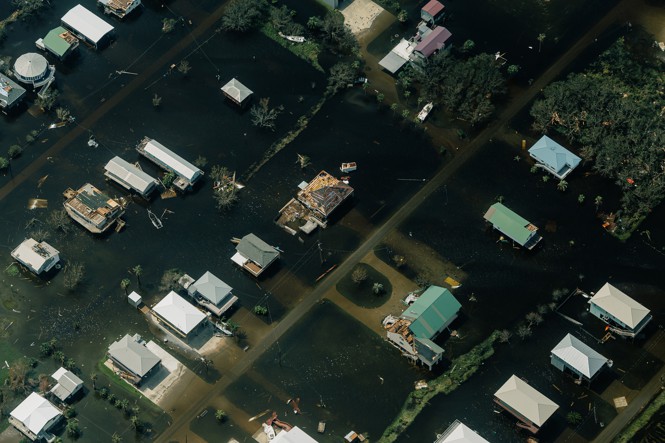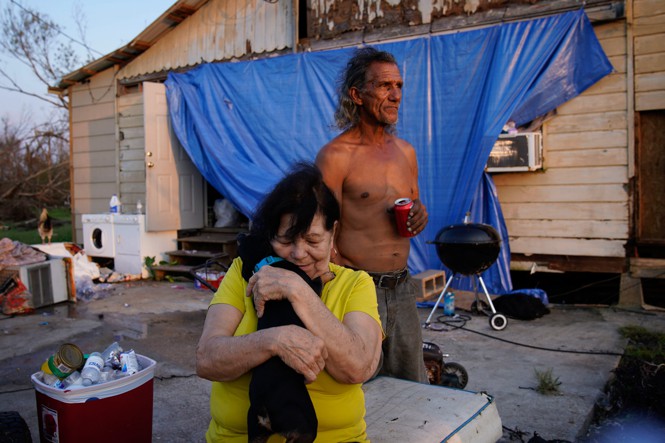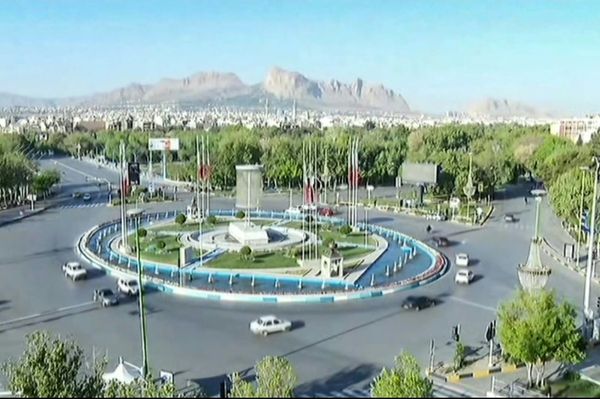
“New Orleans is the only ship I’d go down with,” my friend Ben wrote on Facebook in the hours before Hurricane Ida upended southeast Louisiana. He rode out the storm in the city—“hunkering down,” in standard hurricane parlance. Anxious but safe, I read his post at a splash pad in Tuscaloosa, Alabama. My family and I had evacuated New Orleans the day before, on August 28—two dogs, two kids, and two adults—our destination determined by the projected path of the storm and the availability of an animal-friendly rental. Though far from the “ship,” we monitored Ida’s movements obsessively. The updates weren’t encouraging: The storm intensified at an unprecedented rate, and by the time it reached Grand Isle, the only inhabited barrier island in Louisiana, wind was blasting at 150 mph, making it just shy of a Category 5, the highest in our hurricane-rating system.
Three weeks earlier, my daughter had contracted COVID-19 at her day care, so my kids and I had been in isolation. But my husband, Yussef, an infectious-disease doctor, had continued to see patients, a necessity at his overburdened hospital. Then the hurricane arrived just as the state’s fourth coronavirus wave crested, prompting Louisianans to scatter across the poorly vaccinated South. Yussef and I framed our evacuation as a lark—surprise vacation!—but our daughter detected our worry. As he parked our rental car in downtown Tuscaloosa, Yussef turned to me and asked: “Would any of this be happening if we lived somewhere else?”
He’s not the only one questioning the viability of life in southeast Louisiana. Each time a big hurricane hits, many coastal residents move away, permanently escaping our region’s cycle of destruction and rebuilding. But the choice to leave is far from easy. Hurricane season is fickle; some years the storms skirt the state entirely, other years they pummel our coast over and over again. Such unpredictability presents a conundrum for inhabitants of Gulf states. How do you weigh the various costs of leaving—financial, cultural, and emotional—against an uncertain future? For many, the scale teeters more than tips, the decision as clouded as a thundering sky.

When morning arrived, we learned that New Orleans’s levees had held and that flooding was minimal. Still, the city had taken a hit, and Louisiana’s electrical grid had been decimated. “Looks okay to me,” a neighbor wrote when she texted me photos of my house. I was so relieved that for a minute I felt vindicated, interpreting the news as proof that my decision to live in New Orleans, to raise kids here, to fall in love with the people as much as the place, was right and good and wise. Minutes later, I recognized the feeling for the mirage that it was. Ida’s eye had passed about 30 miles west of New Orleans: My luck was someone else’s tragedy. Grand Isle had been wrecked—pieces of its raised houses were scattered like toothpicks and chunks of asphalt had been lifted off the main road. And in Louisiana’s bayou country, winds shredded roofs and walls; an estimated 13,000 houses were destroyed. Fifteen Native communities were in the direct path of the storm. Members of the Isle de Jean Charles band of the Biloxi-Chitimacha-Choctaw Tribe, the Pointe-au-Chien Tribe, and the Houma Nation experienced the spoliation of their current and ancestral homes.
[Read: ‘One oppressive economy begets another’]
If Hurricane Katrina taught the nation a lesson about infrastructure, then Hurricane Ida hammered home the reality of climate change. Oceanic and atmospheric temperature shifts have altered storm patterns, increasing the frequency and likelihood of mammoth hurricanes that rapidly intensify before landfall. Louisiana’s wetlands and barrier islands, which used to take the brunt of the storms, are rapidly vanishing, in part because of salt-water intrusion from oil and gas dredging. As a result, there’s little to slow storms when they come inland. More and more often, they hit with full force. The risk of devastation is high enough that some meteorologists have begun advocating for the creation of a new rating, Category 6, for hurricanes with sustained winds above 180 mph.
How much longer southeast Louisiana can sustain coastal communities is unclear. Hurricane Katrina already displaced more than half of New Orleans’s estimated pre-storm population of 485,000. And though some residents returned, others found themselves unwilling or unable to come back. Today roughly 390,000 people live in New Orleans, but the city’s demographics have shifted considerably. The 2020 census shows that 94,276 fewer African Americans live in New Orleans now than did in the year 2000, a staggering loss for a city built on Black labor and culture. One woman, a retired Black postal worker with chronic illnesses, told me over the phone that she’s ready to leave the state. She moved from her hometown of Baton Rouge to New Orleans in 2018 to be closer to her doctors, but after getting evacuated twice from hospitals—before and after Hurricane Ida—she doesn’t want to risk another storm.
Conversely, the Hispanic population has grown since Katrina, and the white population has mostly rebounded—in large part because of people like me, newcomers who moved here from other cities. The influx of white professionals has fueled citywide gentrification, exacerbating existing racial and economic inequalities and displacing the very culture bearers who make this place extraordinary. And yet, despite the steady growth of the transplant population, some locals believe that Hurricane Ida will reverse this trend, prompting enough white flight to slow, or even reverse, gentrification.
[Read: How humans sank New Orleans]
At least one part of this prediction—that the last to arrive in the city will be the first to leave—is backed by psychology. “For people who have lived in an area a long time, you think of yourself as being from that place. It’s an important part of your identity,” Susan Clayton, a co-editor of Psychology and Climate Change and a professor at the College of Wooster, in Ohio, told me over phone. Deeper roots, she explained, can make people more reluctant to leave, a dilemma apparent in New Orleans. Prior to Katrina, New Orleans had the highest percentage of residents who had been born in state of any major American city, a statistic that reveals just how loyal New Orleanians are to their home. But the intensity of this relationship can be a hazard, Clayton said. You “might be motivated to want to believe that it’s not as dangerous as maybe it really is.” What’s more, Louisiana has the second-highest poverty rate in the country. For many in the state, leaving is not an option.

More than a month after Ida hit, the region has yet to recover. Some areas still lack electricity and, in places, potable tap water. Many schools are only just now opening, and a number of businesses have permanently closed. In bayou country, families are still sheltering in tents and campers, hoping for more permanent solutions from FEMA. Everyone I know is strapped from the expense of evacuation or exhausted from the monotony of staying put. When I run into friends, we compare notes about housing damage, insurance deductibles, and disaster assistance. Even in New Orleans, where we’ve had more access to aid than much of the region, citizens feel neglected by their local government. In parts of the city, trash went uncollected for more than a month. Neighbors told me that 911 was putting callers on hold. “It’s untenable,” Christopher Romaguera, a bartender and writer, told me over the phone. “New Orleans is not taking care of itself.”
[Read: New Orleans’s football stadium reflects the state of the city]
And yet, like many people I’ve talked with since Ida, I feel more beholden to my neighbors than ever. Before President Joe Biden visited our state to survey the damage, before FEMA began assessing houses and sending out checks, before interviews began for disaster food stamps, Louisianans looked out for one another. Mutual-aid groups, set up during the pandemic to assist unemployed service-industry and gig workers, jumped into action. Volunteers tarped roofs, removed felled trees, delivered hot meals, and cared for children, a response more immediate and targeted than anything done by the government or the Red Cross.
Caroline Brazeel, a Louisiana-born public-health practitioner, told me over the phone that she reached her “lowest point” during evacuation, when she decided she could no longer live here. When she returned home, though, the pendulum of her heart swung in the other direction as she cleaned rotten seafood from one neighbor’s freezer and accepted another neighbor’s offer to fix her broken gate. “Where else could I go?” she said. “What’s more important than feeling close to your community, especially after this year of a lack of intimacy and closeness?”
Another New Orleanian, Isabelle Guzman, an integrative-health practitioner whose business has been severely compromised by the pandemic, started volunteering full time during the past month, caring for a family of five who lost their home in Pointe-aux-Chenes. “There was a point where I was just like, I need to take care of myself,” she told me when we spoke in her basement apartment. “I can’t go down with the Titanic, right?” Participating in mutual aid, she said, changed her relationship to southeast Louisiana by intertwining her life with the lives of others with whom she might not have otherwise crossed paths. “I think that there’s a kind of energy this whole situation generated … Your heart gets broken over and over and over. And you think, I can’t handle this. It’s too much. And then somehow, your spirit gets bigger. And you can take more in and you expand.”
Eleven days after Ida passed through New Orleans, the lights came back on in our neighborhood and we returned home. In our air-conditioned living room, I sat with a stack of student papers in my lap and watched my daughter lay a family of dolls side by side in a blue plastic bed. Her preschool was scheduled to reopen the next Monday, and the following week the high school where I teach would resume classes online, a make-do until the damaged buildings were remediated. My neighbors’ roofs were mostly tarped and some had even begun reshingling. Down in bayou country, people without homes were venturing out in boats to catch fish and shrimp. “You live down here, you just get used to … losing everything,” Guzman told me, repeating words she’d heard a fisherman say in Pointe-aux-Chenes. “Then you rebuild.” I marveled at the fisherman’s tenacity and wondered how it would serve him in the years to come. Louisiana’s weather is so out of whack that graphs of recent trends look like errors. “Climate change [is] an existential threat because it calls into question some very basic assumptions,” Clayton, the College of Wooster professor, said. “We all take for granted that the world is not going to change fundamentally.”
It’s too soon to tell how this storm will reshape southeast Louisiana, who will stay and who will leave, or when the next big hurricane will come. What I want most—an escape from the hazards of our progressively more unstable planet—is something no one can have. These days I think about how best to prepare my children and students for the unprecedented years to come and reflect on the lessons Ida has already taught me: to prioritize your safety and the safety of others, to go toward the hurt instead of away from it, to take care of your family and be a good neighbor, to accept help. I hope they are enough.
“Mama,” my daughter said on that day we returned, stirring me from grading papers, “look!” When I walked over to her dollhouse, I saw that she’d pulled a rug from one of the rooms and repurposed it, placing it on the roof to make a tarp.




